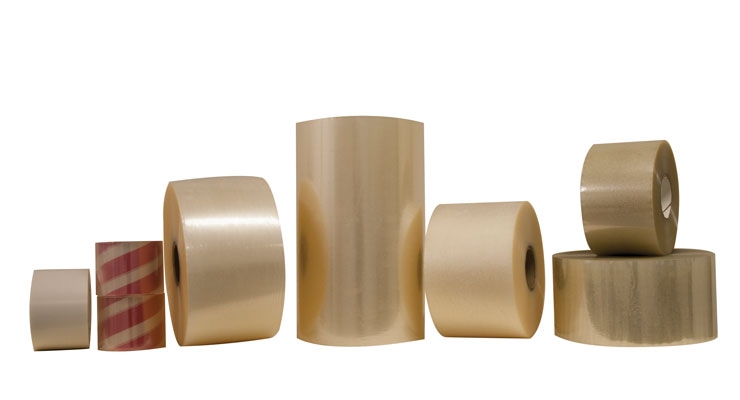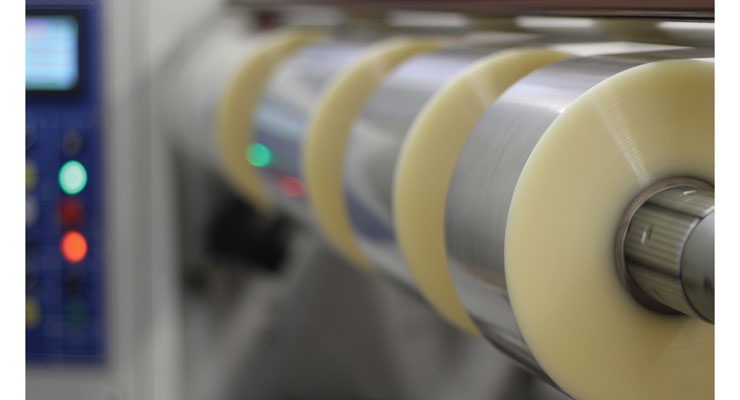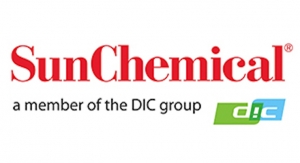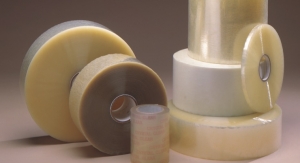Steve Katz, Editor10.14.16
The primary role of an overlamination film is to protect the graphics underneath it. It’s been said that these materials are the “unsung heroes” of a pressure sensitive label construction. After all, you might not even know it’s there unless it fails, when the inks or substrates it’s protecting become blemished.
According to Howard Shen, QSPAC’s director of overlamination products, the main role of an overlamination film is to protect the printing on a label. “It protects the label from moisture, chemicals, oils, acid, dirt, abrasion and even UV rays,” he says. “There are several other benefits as well. Overlamination films are less expensive compared to linered overlaminates, they are easy to use and set up on press. Plus, they add strength and durability to the label – thus adding value to the finished product.”
Cindy Dunfee, marketing coordinator for acpo, says, “Overlaminates are often the last thought of part of a PS label, however they can have a positive or negative effect on the appearance and performance of the overall label. The overlaminate not only protects and enhances the label graphics, it is also functional. For example, acpo manufactures products, such as heat sealable, UV screening, low COF for high-speed fill lines, variable data printable and overlaminates used as open/close mechanisms in extended content labels (ECL). Not giving consideration to what you’re putting on the label may cause end-use failure, rejection or non-compliance.”
Sometimes, however, overlaminates are used for aesthetic purposes. “For instance, if you want to add a glossing or matte appearance, but even then, it’s used to protect the graphics and provide extra durability,” says Ron Ducharme, product manager at FLEXcon.
Overlaminate materials come in a roll format, and are applied after the printing is complete and the ink is dried on press. “There is a nip roller that applies pressure where the overlaminate and substrate meet before the diecutting station,” Shen explains.
Adds Ducharme, “Overlaminates are always applied by machine; never by hand. The process typically includes an unwind stand, lamination roller and base roller. In the converting process, the base roller is stripped to release the liner and then the pressure roller applies constant contact to the surface of the printing graphics while its moving inline.”
In terms of key challenges, there are a few issues related to converting labels with overlamination that can arise. “In the process, you’re adding thickness in diecutting, so the die needs to be prepared and ready to handle extra thickness,” Ducharme explains. “Depending on how sharp the die is, you could get a little bit of adhesive flow out or adhesive halo. The most common challenges are tension and pressure in the process. Tension can be caused by too much brake or tighter release common in selfwound laminates. The result of either will be upcurl in the transverse direction, with the edges of the labels pulling away from the application surface. The second form of too much pressure is when you squeeze the laminate by using too much pressure. This will result with up or down curl in the opposite corners of the labels. The other major challenge that can arise when you’re applying any overlaminate is static. Static can often cause the materials to draw in outside dirt and debris, which can be problematic.”
What follows are insights into overlamination’s role in the label industry, as well as information on the latest products and services from the industry’s overlamination experts.
ACPO
The overlaminate films supplied by acpo are used in a wide range of markets - everywhere from health and beauty to industrial, pharmaceutical, pet food and even aeronautics. “The ease of use and consistency of selfwound overlaminates over UV varnishes or press-applied films greatly benefits the label converter by helping to ensure the first label looks like the last,” Dunfee says. “It also frees up a print station and reduces non-productive time spent dialing in the varnish or adhesive and clean up.”
According to Dunfee, an area of exceptional growth acpo is seeing is in the flexible packaging market. “Several years ago, we introduced our first flexible packaging overlaminate, a 48 gauge PET. We’ve since added heat sealable films and are launching BarrierFlex, a line of printable films featuring a high oxygen barrier coating that is highly durable and flex crack resistant.”
Not surprisingly, digital printing technology continues to expand in the label and flexible packaging market, and acpo has taken note. “The demand is growing for a wide range of robust selfwound overlaminates designed to work specifically with these digital printers and finishers,” Dunfee says. “Digital printing has evolved beyond short runs and personalization. High-end graphic capabilities, flexibility and low cost setup have elevated digital printing to assist brand owners to expand and achieve more customized marketing strategies. To meet this demand, acpo manufactures several selfwound overlaminates coated with our proprietary tackified adhesive developed specifically for digital printers such as HP Indigo.”
Polypropylene (BOPP) overlaminates are acpo’s most popular for indoor label applications, including extended content, food and beverage and household goods. “These films provide scuff resistance and additional overall stability to the label at an attractive price point,” Dunfee says.
For more demanding or outdoor applications, Dunfee recommends polyester (PET) overlaminates. She says, “PET films provide higher fade and heat resistance and overall durability than BOPPs, making them ideal for industrial equipment labels and any application requiring UL compliance.”
In terms of new products, 2016 has been an exciting year for acpo, and 2017 will bring even more offerings. “As the leading manufacturer and supplier of overlaminates, we are proud of our dedication to new product development. We’ve recognized the desire for innovative products in the label and flexible packaging markets and are uniquely positioned to meet that need. Among the new products we’re manufacturing are anti-counterfeit, soft touch and high barrier flexible packaging film products,” says Dunfee.
Counterfeiting costs brand owners and US businesses over $250 billion annually. To help combat this, acpo has developed multiple selfwound overlaminate products with embedded security features. With options of hidden customized messages, visual and audible authentication or layered technologies, acpo makes anti-counterfeit measures easy to implement and verify.
Recently, acpo partnered with Sun Chemical to provide SunBar coated films to flexible packaging converters. “These clear films will give converters a cost-effective alternative to multi-layer and PVDC coated barrier films while providing ultra-high oxygen barrier properties, flex crack resistance and thermal resistance to support high-speed filling on packaging lines and pouch converting equipment. Excellent print reception will eliminate the need for a third layer, which supports package lightweighting, economics and efficiency,” Dunfee explains.
Acpo’s soft touch films can be utilized on both labels and flexible packaging where a high-end, luxury look and feel is desired. The soft tactile sensation and matte finish will set the end product apart from others. “We’re living and breathing our tagline – Films with Technology. Products with Purpose,” Dunfee says.
With a commitment to the future and providing the best possible service to its customers, acpo has been growing its manufacturing and distribution network: “By early 2017, we will have not only two manufacturing facilities in the US, but also five slitting and warehousing locations across the US and one in Mexico. Manufacturing assets include five high-speed, state-of-the-art wide web coaters and 50 slitters.We offer technical expert visits to customer sites to train and educate along with product development and custom solutions,” Dunfee says. “Acpo is the industry leader in selfwound overlaminates but still has the ability to grow, has made the investments and is prepared for that growth.”
QSPAC
“Selfwound overlamination products have been used and accepted by printers for over 30 years, as the the product is very easy to use,” Howard Shen explains. “The most common challenge is tension control. Poor tension control can lead to label curls and wrinkles.” QSPAC offers a silencer attachment that makes converting overlamination much easier. The silencer reduces the noise and maintains the tension during the unwinding of the roll.
QSPAC’s overlamination films are applicable to many markets, including food and beverage, household, personal care, health and beauty, promotions and coupons, industrial, pharmaceutical and medical, games and sweepstakes, dairy, automotive and car care.
“All these markets are a good fit for using overlamination. A lot of clear-on-clear labels are used on beverages and personal care products. Matte finish overlamination is used on health and beauty products. Extended content labels for the pharmaceutical industry use overlamination. Dairy labels and food products are laminated. Car batteries and car care products are laminated. Ladder labels are laminated.”
According to Shen, the food & beverage and personal care markets are experiencing growth. “And the Central and South American market is also growing. We are also focusing more on the European market,” he says,
QSPAC’s two most popular lamination products among label customers are the clear and matte finish. “Both are BOPP films and coated with emulsion acrylic adhesive. Both products are used to protect the label and give the label either a glossy or matte finish look. We are currently working on several new products that will offer our customers a much more competitive cost.”
FLEXcon
Durables and outdoor graphics are the most common label markets for overlamination films, FLEXcon’s Ducharme notes. “The reason for that is purely performance-based,” he says. “Overlaminating polyester can resist temperature extremes, exposure to oils and gases, abrasion and chemical exposure. The most popular overlamination materials are clear polyesters and frosty clear embossed vinyls for aesthetic purposes.”
FLEXcon’s polyesters come in two different formats. The first is the DPM clear gloss or clear matte polyesters, which can be used for two-year outdoor durable applications. The second is the DPM UV clear gloss and UV clear matte polyester overlaminates, which can provide up to five years of outdoor durable protection. “These materials yield excellent clarity and label protection, are highly durable and protect graphics from extended UV light exposure,” explains Ducharme.
FLEXcon’s newest film product is DURApro OF 120 CLEAR, which is a fluoropolymer film designed for durable goods overlaminating applications. The advantages of this product are that it provides excellent UV protection for up to seven years and provides longer exterior outdoor durability.
ACHEM
Achem supplies the label industry with an extensive line of overlamination products. Its Clear Advantage products are constructed of clear or matte polypropylene or polyester films in a number of thicknesses, matched with various adhesive systems (primarily emulsion acrylic) designed to address the broad range of requirements of label manufacturers.
A short roll program has recently been established in order to provide a reliable source for quick delivery and consistent pricing to commonly required products for less than standard length rolls, including many digital presses.Achem also offers the Paybacker, a press attachment that provides consistent unwind tension, allowing for faster speeds, tighter registration, less label curl and less noise than normally associated with selfwound products.
According to Howard Shen, QSPAC’s director of overlamination products, the main role of an overlamination film is to protect the printing on a label. “It protects the label from moisture, chemicals, oils, acid, dirt, abrasion and even UV rays,” he says. “There are several other benefits as well. Overlamination films are less expensive compared to linered overlaminates, they are easy to use and set up on press. Plus, they add strength and durability to the label – thus adding value to the finished product.”
Cindy Dunfee, marketing coordinator for acpo, says, “Overlaminates are often the last thought of part of a PS label, however they can have a positive or negative effect on the appearance and performance of the overall label. The overlaminate not only protects and enhances the label graphics, it is also functional. For example, acpo manufactures products, such as heat sealable, UV screening, low COF for high-speed fill lines, variable data printable and overlaminates used as open/close mechanisms in extended content labels (ECL). Not giving consideration to what you’re putting on the label may cause end-use failure, rejection or non-compliance.”
Sometimes, however, overlaminates are used for aesthetic purposes. “For instance, if you want to add a glossing or matte appearance, but even then, it’s used to protect the graphics and provide extra durability,” says Ron Ducharme, product manager at FLEXcon.
Overlaminate materials come in a roll format, and are applied after the printing is complete and the ink is dried on press. “There is a nip roller that applies pressure where the overlaminate and substrate meet before the diecutting station,” Shen explains.
Adds Ducharme, “Overlaminates are always applied by machine; never by hand. The process typically includes an unwind stand, lamination roller and base roller. In the converting process, the base roller is stripped to release the liner and then the pressure roller applies constant contact to the surface of the printing graphics while its moving inline.”
In terms of key challenges, there are a few issues related to converting labels with overlamination that can arise. “In the process, you’re adding thickness in diecutting, so the die needs to be prepared and ready to handle extra thickness,” Ducharme explains. “Depending on how sharp the die is, you could get a little bit of adhesive flow out or adhesive halo. The most common challenges are tension and pressure in the process. Tension can be caused by too much brake or tighter release common in selfwound laminates. The result of either will be upcurl in the transverse direction, with the edges of the labels pulling away from the application surface. The second form of too much pressure is when you squeeze the laminate by using too much pressure. This will result with up or down curl in the opposite corners of the labels. The other major challenge that can arise when you’re applying any overlaminate is static. Static can often cause the materials to draw in outside dirt and debris, which can be problematic.”
What follows are insights into overlamination’s role in the label industry, as well as information on the latest products and services from the industry’s overlamination experts.
ACPO
The overlaminate films supplied by acpo are used in a wide range of markets - everywhere from health and beauty to industrial, pharmaceutical, pet food and even aeronautics. “The ease of use and consistency of selfwound overlaminates over UV varnishes or press-applied films greatly benefits the label converter by helping to ensure the first label looks like the last,” Dunfee says. “It also frees up a print station and reduces non-productive time spent dialing in the varnish or adhesive and clean up.”
According to Dunfee, an area of exceptional growth acpo is seeing is in the flexible packaging market. “Several years ago, we introduced our first flexible packaging overlaminate, a 48 gauge PET. We’ve since added heat sealable films and are launching BarrierFlex, a line of printable films featuring a high oxygen barrier coating that is highly durable and flex crack resistant.”
Not surprisingly, digital printing technology continues to expand in the label and flexible packaging market, and acpo has taken note. “The demand is growing for a wide range of robust selfwound overlaminates designed to work specifically with these digital printers and finishers,” Dunfee says. “Digital printing has evolved beyond short runs and personalization. High-end graphic capabilities, flexibility and low cost setup have elevated digital printing to assist brand owners to expand and achieve more customized marketing strategies. To meet this demand, acpo manufactures several selfwound overlaminates coated with our proprietary tackified adhesive developed specifically for digital printers such as HP Indigo.”
Polypropylene (BOPP) overlaminates are acpo’s most popular for indoor label applications, including extended content, food and beverage and household goods. “These films provide scuff resistance and additional overall stability to the label at an attractive price point,” Dunfee says.
For more demanding or outdoor applications, Dunfee recommends polyester (PET) overlaminates. She says, “PET films provide higher fade and heat resistance and overall durability than BOPPs, making them ideal for industrial equipment labels and any application requiring UL compliance.”
In terms of new products, 2016 has been an exciting year for acpo, and 2017 will bring even more offerings. “As the leading manufacturer and supplier of overlaminates, we are proud of our dedication to new product development. We’ve recognized the desire for innovative products in the label and flexible packaging markets and are uniquely positioned to meet that need. Among the new products we’re manufacturing are anti-counterfeit, soft touch and high barrier flexible packaging film products,” says Dunfee.
Counterfeiting costs brand owners and US businesses over $250 billion annually. To help combat this, acpo has developed multiple selfwound overlaminate products with embedded security features. With options of hidden customized messages, visual and audible authentication or layered technologies, acpo makes anti-counterfeit measures easy to implement and verify.
Recently, acpo partnered with Sun Chemical to provide SunBar coated films to flexible packaging converters. “These clear films will give converters a cost-effective alternative to multi-layer and PVDC coated barrier films while providing ultra-high oxygen barrier properties, flex crack resistance and thermal resistance to support high-speed filling on packaging lines and pouch converting equipment. Excellent print reception will eliminate the need for a third layer, which supports package lightweighting, economics and efficiency,” Dunfee explains.
Acpo’s soft touch films can be utilized on both labels and flexible packaging where a high-end, luxury look and feel is desired. The soft tactile sensation and matte finish will set the end product apart from others. “We’re living and breathing our tagline – Films with Technology. Products with Purpose,” Dunfee says.
With a commitment to the future and providing the best possible service to its customers, acpo has been growing its manufacturing and distribution network: “By early 2017, we will have not only two manufacturing facilities in the US, but also five slitting and warehousing locations across the US and one in Mexico. Manufacturing assets include five high-speed, state-of-the-art wide web coaters and 50 slitters.We offer technical expert visits to customer sites to train and educate along with product development and custom solutions,” Dunfee says. “Acpo is the industry leader in selfwound overlaminates but still has the ability to grow, has made the investments and is prepared for that growth.”
QSPAC
“Selfwound overlamination products have been used and accepted by printers for over 30 years, as the the product is very easy to use,” Howard Shen explains. “The most common challenge is tension control. Poor tension control can lead to label curls and wrinkles.” QSPAC offers a silencer attachment that makes converting overlamination much easier. The silencer reduces the noise and maintains the tension during the unwinding of the roll.
QSPAC’s overlamination films are applicable to many markets, including food and beverage, household, personal care, health and beauty, promotions and coupons, industrial, pharmaceutical and medical, games and sweepstakes, dairy, automotive and car care.
“All these markets are a good fit for using overlamination. A lot of clear-on-clear labels are used on beverages and personal care products. Matte finish overlamination is used on health and beauty products. Extended content labels for the pharmaceutical industry use overlamination. Dairy labels and food products are laminated. Car batteries and car care products are laminated. Ladder labels are laminated.”
According to Shen, the food & beverage and personal care markets are experiencing growth. “And the Central and South American market is also growing. We are also focusing more on the European market,” he says,
QSPAC’s two most popular lamination products among label customers are the clear and matte finish. “Both are BOPP films and coated with emulsion acrylic adhesive. Both products are used to protect the label and give the label either a glossy or matte finish look. We are currently working on several new products that will offer our customers a much more competitive cost.”
FLEXcon
Durables and outdoor graphics are the most common label markets for overlamination films, FLEXcon’s Ducharme notes. “The reason for that is purely performance-based,” he says. “Overlaminating polyester can resist temperature extremes, exposure to oils and gases, abrasion and chemical exposure. The most popular overlamination materials are clear polyesters and frosty clear embossed vinyls for aesthetic purposes.”
FLEXcon’s polyesters come in two different formats. The first is the DPM clear gloss or clear matte polyesters, which can be used for two-year outdoor durable applications. The second is the DPM UV clear gloss and UV clear matte polyester overlaminates, which can provide up to five years of outdoor durable protection. “These materials yield excellent clarity and label protection, are highly durable and protect graphics from extended UV light exposure,” explains Ducharme.
FLEXcon’s newest film product is DURApro OF 120 CLEAR, which is a fluoropolymer film designed for durable goods overlaminating applications. The advantages of this product are that it provides excellent UV protection for up to seven years and provides longer exterior outdoor durability.
ACHEM
Achem supplies the label industry with an extensive line of overlamination products. Its Clear Advantage products are constructed of clear or matte polypropylene or polyester films in a number of thicknesses, matched with various adhesive systems (primarily emulsion acrylic) designed to address the broad range of requirements of label manufacturers.
A short roll program has recently been established in order to provide a reliable source for quick delivery and consistent pricing to commonly required products for less than standard length rolls, including many digital presses.Achem also offers the Paybacker, a press attachment that provides consistent unwind tension, allowing for faster speeds, tighter registration, less label curl and less noise than normally associated with selfwound products.




















